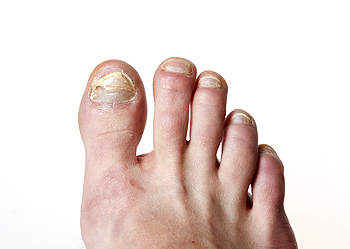
Toenail fungus, medically known as onychomycosis, is a common ailment that not only disfigures but can also lead to the destruction of the toenail. These microscopic fungi, akin to mold and mildew, thrive in the dark, moist, and stuffy environments inside shoes. As they grow, they feed on keratin, the protein responsible for the hard surface of toenails. Several factors increase the risk of developing toenail fungus. Included are wearing tight-fitting shoes, practicing poor foot hygiene, frequent use of toenail polish, and engaging in activities that expose you to communal environments, like showers or locker rooms. Additionally, chronic illnesses, such as diabetes, and circulatory problems that reduce blood flow to the toes can elevate the risk. Common symptoms include yellowing or browning of the toenail, thickening, foul-smelling debris accumulation, and even nail crumble or loss. The big toe and little toe are more prone to toenail fungus, possibly due to the constant friction from shoes. If you are concerned about toenail fungus, it is suggested that you schedule an appointment with a chiropodist.
Toenail fungus can be uncomfortable and unsightly. If you have diabetes or a compromised immune system, it may also be dangerous. To learn more about treatment options, please consult with Chiropodist Stephanie Poupore from North Bay Foot & Ankle. Our clinician will assess your condition and provide you with quality foot and ankle treatment.
What Does Toenail Fungus Look Like?
A fungal infection of the toenail may cause the affected nail to become thickened, brittle, crumbly, and yellowish or brown in color. Sometimes the toenail may separate from the nail bed, become deformed, emit a foul odor, or cause pain or discomfort.
What Causes Toenail Fungus?
Toenail fungus is caused by a fungus that infects the nail bed. The fungus lives and thrives in warm and moist environments and is also contagious. Athlete’s foot, which is a fungal infection of the skin, may spread to the nails and cause toenail fungus.
What Treatments Are Available?
Potential treatments for toenail fungus may include oral antifungal medications, topical antifungal medications, such as medicated nail polishes that are applied directly to the affected nail, and laser therapy. Sometimes, a combination of treatments is prescribed.
If you have any questions, please feel free to contact our office located in . We offer the newest diagnostic and treatment technologies for all your foot care needs.
